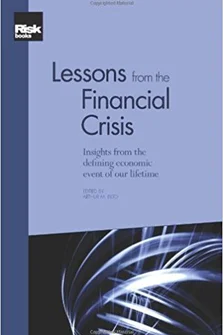Financial Complexity and Systemic Stability in Trading Markets
Matteo Marsili and Kartik Anand
Introduction to 'Lessons from the Financial Crisis'
The Credit Crunch of 2007: What Went Wrong? Why? What Lessons Can be Learned?
Underwriting versus Economy: A New Approach to Decomposing Mortgage Losses
The Shadow Banking System and Hyman Minsky’s Economic Journey
The Collapse of the Icelandic Banking System
The Quant Crunch Experience and the Future of Quantitative Investing
No Margin for Error: The Impact of the Credit Crisis on Derivatives Markets
The Re-Emergence of Distressed Exchanges in Corporate Restructurings
Modelling Systemic and Sovereign Risks
Measuring and Managing Risk in Innovative Financial Instruments
Forecasting Extreme Risk of Equity Portfolios with Fundamental Factors
Limits of Implied Credit Correlation Metrics Before and During the Crisis
Another view on the pricing of MBSs, CMOs and CDOs of ABS
Pricing of Credit Derivatives with and without Counterparty and Collateral Adjustments
A Practical Guide to Monte Carlo CVA
The Endogenous Dynamics of Markets: Price Impact, Feedback Loops and Instabilities
Market Panics: Correlation Dynamics, Dispersion and Tails
Financial Complexity and Systemic Stability in Trading Markets
The Martingale Theory of Bubbles: Implications for the Valuation of Derivatives and Detecting Bubbles
Managing through a Crisis: Practical Insights and Lessons Learned for Quantitatively Managed Equity Portfolios
Active Risk Management: A Credit Investor’s Perspective
Investment Strategy Returns: Volatility, Asymmetry, Fat Tails and the Nature of Alpha
In this chapter we address the systemic consequences of the increased complexity in financial markets. This trend may be thought of as a response to a demand by investors for access to new assets and markets, better transferring and trading of risks and ever higher yields. There are several dimensions in which complexity has increased over past decades. Foremost of these has been the information technology (IT) revolution, which, with the rise of electronic markets, has allowed unfettered trading at ever increasing frequencies. We have witnessed an evolution that has lead to greater diversity in the population of traders in financial markets. This diversity includes, amongst others, hedge funds and investment banks specialising in niche markets and deploying more and more aggressive speculative strategies.11 See the plenary talk of Pliska (2010) at the Sixth World Congress of the Bachelier Finance Society for an overview of the risks and opportunities in electronic market making.
Concurrent with developments on the IT side, the repertoire of trading instruments has expanded considerably, in both scope and volume. Innovations in financial engineering and computational methods have
Copyright Infopro Digital Limited. All rights reserved.
As outlined in our terms and conditions, https://www.infopro-digital.com/terms-and-conditions/subscriptions/ (point 2.4), printing is limited to a single copy.
If you would like to purchase additional rights please email info@risk.net
Copyright Infopro Digital Limited. All rights reserved.
You may share this content using our article tools. As outlined in our terms and conditions, https://www.infopro-digital.com/terms-and-conditions/subscriptions/ (clause 2.4), an Authorised User may only make one copy of the materials for their own personal use. You must also comply with the restrictions in clause 2.5.
If you would like to purchase additional rights please email info@risk.net











